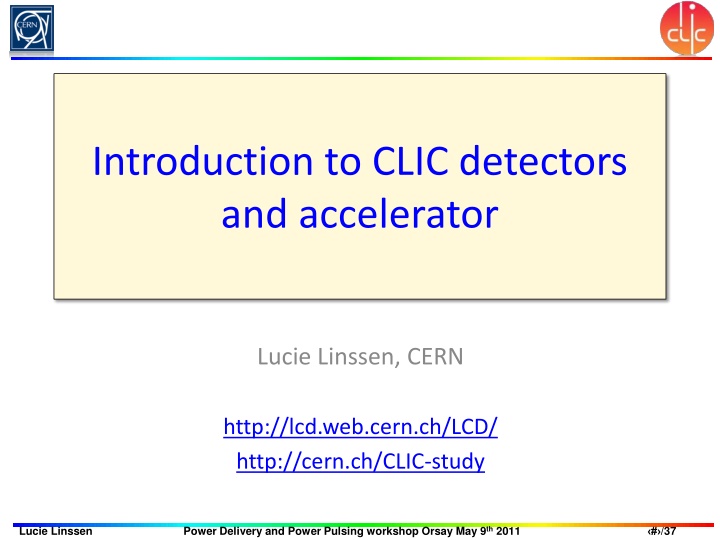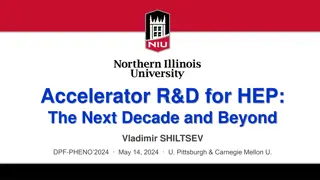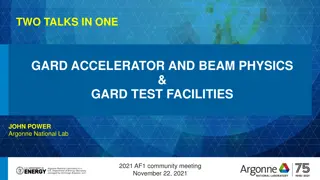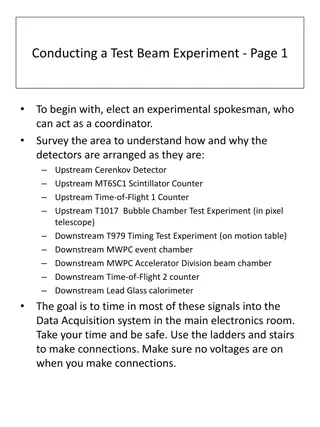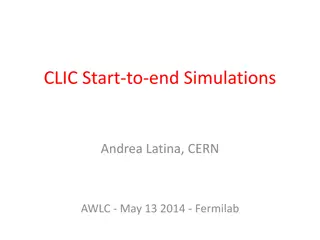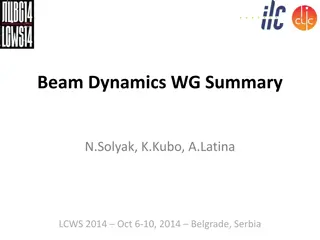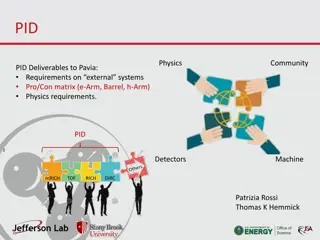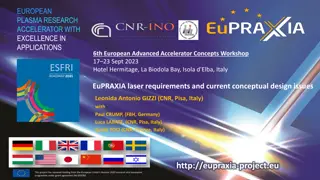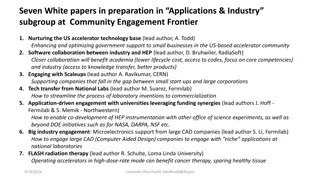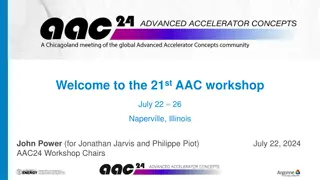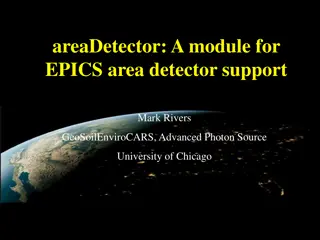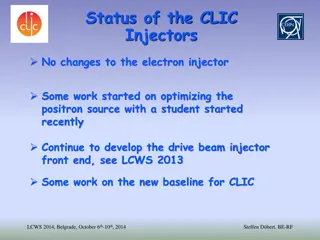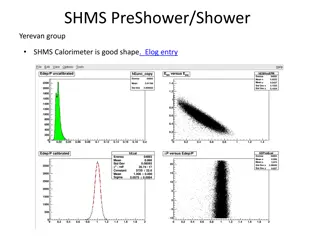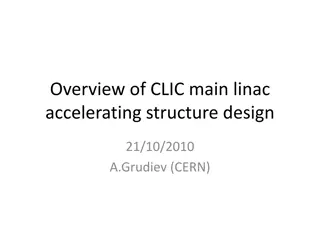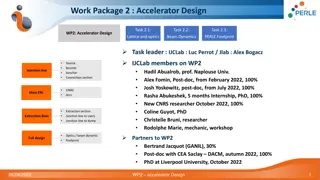Overview of CLIC Detectors and Accelerator Studies
CLIC detectors and accelerator studies aim to explore new physics beyond the current energy scales reached by the LHC. The CLIC project focuses on a linear collider for e+e- collisions, with an energy reach up to 3 TeV. The two-beam scheme, detector concepts, challenges, and comparison to the LHC are key components of CLIC research. Additionally, the CLIC project involves R&D plans and activities for future advancements in high-energy physics.
Download Presentation

Please find below an Image/Link to download the presentation.
The content on the website is provided AS IS for your information and personal use only. It may not be sold, licensed, or shared on other websites without obtaining consent from the author.If you encounter any issues during the download, it is possible that the publisher has removed the file from their server.
You are allowed to download the files provided on this website for personal or commercial use, subject to the condition that they are used lawfully. All files are the property of their respective owners.
The content on the website is provided AS IS for your information and personal use only. It may not be sold, licensed, or shared on other websites without obtaining consent from the author.
E N D
Presentation Transcript
Introduction to CLIC detectors and accelerator Lucie Linssen, CERN http://lcd.web.cern.ch/LCD/ http://cern.ch/CLIC-study Lucie Linssen Power Delivery and Power Pulsing workshop Orsay May 9th 2011 # /37
General (physics) context The LHC has brought us to the threshold of discovery of new physics. We hope to cross it very soon If the new physics is within the centre-of-mass reach for a future linear e+e- collider, the structure of that new physics can be determined with high precision: Higgs sector SUSY Extra Electroweak Symmetry Breaking symmetries, dimensions Physics information from an e+e- Collider is complementary to physics input from pp collisions at LHC LHC will indicate what physics, and at which energy scale The current CLIC detector and accelerator studies address 3 TeV in the centre of mass (the most difficult case). A staged energy approach up to 3 TeV is foreseen for CLIC Lucie Linssen Power Delivery and Power Pulsing workshop Orsay May 9th 2011 # /37
ILC and CLIC in a few words linear collider, producing e+e- collisions ILC CLIC Based on superconducting RF cavities Gradient 32 MV/m Energy: 500 GeV, upgradeable to 1 TeV (lower energies also considered) Detector studies focused until now mostly on 500 GeV Based on 2-beam acceleration scheme Gradient 100 MV/m Energy: 3 TeV, though will probably start at lower energy (~0.5 TeV) Detector study focuses on 3 TeV Luminosities: few 1034 cm-2s-1 Lucie Linssen Power Delivery and Power Pulsing workshop Orsay May 9th 2011 # /37
Outline Introduction to the CLIC accelerator Beam-induced background Detector concepts at CLIC Detector challenges at CLIC Comparison to LHC A bit about sub-detectors Vertex detector Hadron Calorimetry and Particle Flow Analysis (PFA) Current linear collider detector activities @ CERN R&D plans Lucie Linssen Power Delivery and Power Pulsing workshop Orsay May 9th 2011 # /37
The CLIC Two Beam Scheme Two Beam Scheme: Drive Beam supplies RF power 12 GHz bunch structure low energy (2.4 GeV - 240 MeV) high current (100A) Main beam for physics high energy (9 GeV 1.5 TeV) current 1.2 A No individual RF power sources Lucie Linssen Power Delivery and Power Pulsing workshop Orsay May 9th 2011 # /37
CLIC overall layout 3 TeV Drive Beam Generation Complex Drive beam Main beam Main Beam Generation Complex Lucie Linssen Power Delivery and Power Pulsing workshop Orsay May 9th 2011 # /37
CLIC RF power source Drive Beam Accelerator efficient acceleration in fully loaded linac Delay loop 2 gap creation, pulse compression & frequency multiplication Transverse RF Deflectors Combiner ring 3 pulse compression & frequency multiplication Combiner ring 4 pulse compression & frequency multiplication Drive Beam Decelerator Sector (24 in total) Power Extraction Drive beam time structure - final Drive beam time structure - initial 240 ns 240 ns 5.8 s 140 stotal length - 24 24 sub-pulses - 4.2 A 2.4 GeV - 60 cm between bunches 24 pulses 100 A 2.5 cm between bunches Lucie Linssen Power Delivery and Power Pulsing workshop Orsay May 9th 2011 # /37
Two beam Test Stand (TBTS) line DRIVE BEAM PROBE BEAM Lucie Linssen Power Delivery and Power Pulsing workshop Orsay May 9th 2011 # /37
CLIC parameters Lucie Linssen Power Delivery and Power Pulsing workshop Orsay May 9th 2011 # /37
CLIC time structure Train repetition rate 50 Hz 156 ns 20 ms CLIC 1 train = 312 bunches 0.5 ns apart 50 Hz CLIC: ILC: 1 train = 2820 bunches 308 ns apart 5 Hz Lucie Linssen Power Delivery and Power Pulsing workshop Orsay May 9th 2011 # /37
Beam-induced background (1) CLIC luminosity spectrum 30% in 1% highest energy Main backgrounds: CLIC 3TeV beamstrahlung E/E = 29% (10 ILCvalue) Coherent pairs (3.8 108 per bunch crossing) <= disappear in beam pipe Incoherent pairs (3.0 105 per bunch crossing) <= suppressed by strong solenoid-field interactions => hadrons (3.3 hadron events per bunch crossing) In addition: Muon background from upstream linac (~5 muons per bunch crossing) <= spread over detector surface Lucie Linssen Power Delivery and Power Pulsing workshop Orsay May 9th 2011 # /37
Beam-induced background (2) Coherent pairs: Very numerous at very low angles Very high total energy Incoherent pairs: Extend to larger angles More difficult for the detector Determines beam crossing angle (20 mrad) Determines opening angle of beam pipe for outgoing beam ( 10 mrad) Lucie Linssen Power Delivery and Power Pulsing workshop Orsay May 9th 2011 # /37
Beam-induced background (3) CLIC beamstrahlung: hadrons Per bunch crossing: 3.2 such events ~28 particles into the detector 50 GeV Forward-peaked 15 TeV dumped in the detector per 156 ns bunch train ! we need TIME STAMPING ! and play with clever event selections D. Dannheim, CERN Lucie Linssen Power Delivery and Power Pulsing workshop Orsay May 9th 2011 # /37
Experiment: Elements/technologies O(109) readout cells Final Focus quadrupole of accelerator (0.3 nm stability) Yoke instrumentation (glass RPC s or scintillator detectors) Solenoid coil (superconducting, 4-5T, 7-6 m diam.) PFA Calorimetry (tungsten, steel, silicon, scintillator, RPC) 6 m Main tracker (silicon strips 50 m, TPC gas detector) Pixel detector (silicon pixels 20 m) Lucie Linssen Power Delivery and Power Pulsing workshop Orsay May 9th 2011 # /37
Validated ILC experiments CLIC detector concepts will be based on SiD and ILD. Modified to meet CLIC requirements Lucie Linssen Power Delivery and Power Pulsing workshop Orsay May 9th 2011 # /37
CLIC_SiD and CLIC_ILD Lucie Linssen Power Delivery and Power Pulsing workshop Orsay May 9th 2011 # /37
CLIC_SiD experiment Lucie Linssen Power Delivery and Power Pulsing workshop Orsay May 9th 2011 # /37
Details of forward detector region Lucie Linssen Power Delivery and Power Pulsing workshop Orsay May 9th 2011 # /37
Two experiments in push-pull e- e+ Lucie Linssen Power Delivery and Power Pulsing workshop Orsay May 9th 2011 # /37
Detector design challenges Marcel Demarteau ANL Lucie Linssen Power Delivery and Power Pulsing workshop Orsay May 9th 2011 # /37
Comparison CLIC LHC detector In a nutshell: CLIC detector: LHC detector: High precision: Jet energy resolution => fine-grained calorimetry Momentum resolution Impact parameter resolution Medium-high precision: Very precise ECAL (CMS) Very precise muon tracking (ATLAS) Overlapping beam-induced background: High background rates, medium energies High occupancies Cannot use vertex separation in z Need precise time-stamping (5-10 ns) Overlapping minimum-bias events: High background rates, high energies High occupancies Can use vertex separation in z Need precise time-stamping (25 ns) No issue of radiation damage (10-4 LHC) Severe challenge of radiation damage Beam crossings sporadic Continuous beam crossings No trigger, read-out of full 156 ns train Trigger has to achieve huge data reduction Lucie Linssen Power Delivery and Power Pulsing workshop Orsay May 9th 2011 # /37
CLIC tracking/calorimetry issues Due to beam-induced background and short time between bunches: High occupancy in the inner regions (incoherent pairs) Jets scale and resolution are affected ( =>hadrons) Time-stamping is a must for almost all detectors Narrow jets at high energy Calorimeter has to measure high-energy particles (leakage) Separation of tracks in dense jets 3TeV e+e- t tbar Lucie Linssen Power Delivery and Power Pulsing workshop Orsay May 9th 2011 # /37
CLIC vertex detector region CLIC_ILD CLIC_ILD 3 double layers of pixel cylinders 3 double layers of pixel disks 20 m pixels, analog readout, sp=2.8 m X=0.18% X0 / double layer 0.74m2 surface, 1.84G Pixel Vertex region CLIC_SiD 5 single layers of barrel pixel cylinders 7 single layers of forward pixel disks 20 m pixels, binary (analog) r/o, sp=3-4 m X=0.12% X0 / single layer 1.1m2 surface, 2.77G Pixel CLIC_SiD Vertex region D. Dannheim, CERN Lucie Linssen Power Delivery and Power Pulsing workshop Orsay May 9th 2011 # /37
CLIC vertex detector Requirements for the vertex detector: Single-layer position resolution 3-4 m Typically achieved with 20*20 micron pixels Single-layer material thickness 0.1%X0 0.2%X0 Equivalent to 50 m thick sensor + 50 m thick readout chip + thin support + connect Requires very low power dissipation => no liquid cooling ( air flow ) Requires power pulsing (factor ~50 in heat dissipation) Time-stamping ~5-10 ns Still needs more study with full simulation Occupancy ~1.5% per 20*20 m2 pixel per bunch train (156 ns) in the innermost layer Triggerless readout over the 156 ns bunch-train With full data readout in less than 200-400 sec to allow power-pulsing o o o o o o o o Very challenging hardware project ! Lucie Linssen Power Delivery and Power Pulsing workshop Orsay May 9th 2011 # /37
Some tracking/vertex pictures (LC!) SiD vertex detector and silicon tracking 3D view of ILD vertex detector and beam pipe R&D on hybrid-less silicon strip detectors (SiD) Lucie Linssen Power Delivery and Power Pulsing workshop Orsay May 9th 2011 # /37
Some TPC pictures Lucie Linssen Power Delivery and Power Pulsing workshop Orsay May 9th 2011 # /37
Tungsten HCAL => prototype Motivation: To limit longitudinal leakage CLIC HCAL needs ~7 i A deep HCAL pushes the coil/yoke to larger radius (would give a significant increase in cost and risk for the coil/yoke) A tungsten HCAL (CLIC option) is more compact than Fe-based HCAL, (ILC option) while Geant4 performance is similar Increased cost of tungsten barrel HCAL compensates gain in coil cost Prototype tungsten HCAL: check simulation in test beam Prototype tests performed within CALICE collab. Use 30-40 layers of Tungsten, 1 cm thick, 80 cm Use different active materials Start in Nov 2010 at CERN PS, with 30 W plates, and scintillator planes; continue in 2011 at SPS with 38 planes. +T3B tests for precise time measurement of shower development Lucie Linssen Power Delivery and Power Pulsing workshop Orsay May 9th 2011 # /37
Tungsten HCAL prototype Stack of 30-39 tungsten plates 10 mm thick 80 cm diameter Main purpose: Validation of Geant4 simulation for hadronic showers in tungsten Scintillator tiles 3*3 cm (in the centre) Read out by SiPM (and wave-length shifting fibre) Lucie Linssen Power Delivery and Power Pulsing workshop Orsay May 9th 2011 # /37
Tungsten HCAL module Lucie Linssen Power Delivery and Power Pulsing workshop Orsay May 9th 2011 # /37
PandoraNewPFAs 1 TeV Z=>qqbar with 60 BX background 1.4 TeV of background !
LooseSelectedPandoraNewPFAs 0.3 TeV of background
SelectedPandoraNewPFAs 0.2 TeV of background
TightSelectedPandoraNewPFAs 0.1 TeV of background Mark Thomson, Cambridge
Current CLIC detector activities Current activities concentrate on preparation for CDR Mostly simulation studies: Demonstrate that CLIC physics potential can be extracted from detector Propose ILD-type and SiD-type detectors that can do the job Perform physics benchmark studies Concentrate on critical issues Determine required sub-detector performances to see the physics Redesign of the very forward region Take engineering aspects, cost etc into account Targeted hardware R&D (on critical elements) Conceptual Design Report due for August 2011 (for 3 TeV), and end-2011 (including strategies for intermediate energies) Lucie Linssen Power Delivery and Power Pulsing workshop Orsay May 9th 2011 # /37
Hardware/engineering R&D CERN LCD hardware/engineering R&D (needed for CLIC beyond existing ILC developments): Vertex detector trade-off between pixel size, amount of material and timing resolution Hadron calorimetry Tungsten-based HCAL (PFA calo, within CALICE) Power pulsing In view of the 50 Hz CLIC time structure => allows for low-mass detectors Solenoid coil Large high-field solenoid concept, reinforced conductor (CMS/ATLAS experience) Overall engineering design and integration studies In view of sub-nm precision required for FF quadrupoles For heavier calorimeter, larger overall CLIC detector size etc. In addition at CERN: TPC electronics development (Timepix-2, S- ALTRO) Lucie Linssen Power Delivery and Power Pulsing workshop Orsay May 9th 2011 # /37
Power delivery /power pulsing Why do we care about power delivery and power pulsing? Power delivery: Reduce the total current to be brought into the detectors For exactly the same reasons as LHC => synergy with sLHC work Reduced space for services, reduced mass of cables and cooling Power pulsing => potential large impact on power requirements and cooling requirements: Main reason is different for tracking and calorimetry Calorimetry: Important to have very compact showers => important to make active layer very thin in space. This is achievable if no space for cooling pipes is needed Vertex detector and tracking detectors High precision requirements at LC call for ultra-thin vertex/tracking detectors If air-cooling can be used, the required low material budgets come within reach Lucie Linssen Power Delivery and Power Pulsing workshop Orsay May 9th 2011 # /37
Thank you! Lucie Linssen Power Delivery and Power Pulsing workshop Orsay May 9th 2011 # /37
SPARE SLIDES Lucie Linssen Power Delivery and Power Pulsing workshop Orsay May 9th 2011 # /37
CLIC machine parameters Parameter Value Center-of-mass energy s 3 TeV 5.9x1034 cm-2 s-1 Instantaneous peak luminosity 500 fb-1 Integrated luminosity per year Beam crossing angle 20 mrad Train length 156 ns Nbunches / train Train repetition rate 312 (every 0.5 ns) 50 Hz IP size x/y/z # hadrons / bx 45 nm / 1 nm / 40 m 3.2 3 x 105 # incoherent electron pairs / bx Lucie Linssen Power Delivery and Power Pulsing workshop Orsay May 9th 2011 # /37
CLIC physics up to 3 TeV What can CLIC provide in the 0.5-3 TeV range? In a nutshell Higgs physics: Complete study of the light standard-model Higgs boson, including rare decay modes (rates factor ~5 higher at 3 TeV than at 500 GeV) Higgs coupling to leptons Study of triple Higgs coupling using double Higgs production Study of heavy Higgs bosons (supersymmetry models) Supersymmetry: Extensive reach to measure SUSY particles Including weakly interacting SUSY particles And in addition: Probe for theories of extra dimensions New heavy gauge bosons (e.g. Z ) Excited quarks or leptons Mass measurements ~5-10 times better than LHC (tbc) Lucie Linssen Power Delivery and Power Pulsing workshop Orsay May 9th 2011 # /37
(S)LHC, ILC, CLIC reach LHC 100 fb-1 ILC SLHC 1000 fb-1 CLIC 3 TeV 1000 fb-1 800 GeV 500 fb-1 Squarks (TeV) Sleptons (TeV) New gauge boson Z (TeV) Excited quark q* (TeV) Excited lepton l* (TeV) Two extra space dimensions (TeV) Strong WLWL scattering Triple-gauge Coupling (95%) 2.5 0.34 5 0.4 0.4 8 3 1.5 1.5 22 6 6.5 0.8 7.5 3 3.4 0.8 3 9 5-8.5 12 20-35 - 2 4 70 .0014 0.0004 0.0006 0.00013 Gian Giudici, CERN Lucie Linssen Power Delivery and Power Pulsing workshop Orsay May 9th 2011 # /37
The CLIC Test Facility (CTF3) Small scale version of the CLIC drive beam complex DELAY LOOP 4 A 1.2 s 150 Mev 1.5 GHz bunch spacing COMBINER RING DRIVE BEAM LINAC 32 A 140 ns 150 Mev 12 GHz bunch spacing CLEX CLIC Experimental Area 10 m Lucie Linssen Power Delivery and Power Pulsing workshop Orsay May 9th 2011 # /37
Factor 8 combination achieved ~ 27 A combined beam current reached, nominal 140 ns pulse length Full drive beam generation, main goal of CTF3, achieved CTF3 #1 2 DL DBA CR 3 CTF2 <30A TBTS CLEX 1 1 - current from linac 2- current after delay loop 3 - current in the ring Lucie Linssen Power Delivery and Power Pulsing workshop Orsay May 9th 2011 # /37
Drive Beam Deceleration and Module: CLEX CLIC Decelerator sector: ~ 1 km, 90% of energy extracted Two-beam Test Stand (TBTS): Single PETS with beam Accelerating structure with beam wake monitor kick on beam from break down Integration Test Beam Line (TBL): Drive beam transport (16 PETS) beam energy extraction and dispersion wakefield effects Califes: Probe beam photo-injector Beam energy 175 MeV Lucie Linssen Power Delivery and Power Pulsing workshop Orsay May 9th 2011 # /37
Two Beam Module G. Riddone et al. Installation in the CLEX facility Lucie Linssen Power Delivery and Power Pulsing workshop Orsay May 9th 2011 # /37
Demonstration of 2-beam acceleration Test in CLEX, very recent result Lucie Linssen Power Delivery and Power Pulsing workshop Orsay May 9th 2011 # /37
Test facilities around the globe Lucie Linssen Power Delivery and Power Pulsing workshop Orsay May 9th 2011 # /37
World-wide CLIC&CTF3 Collaboration http://clic-meeting.web.cern.ch/clic-meeting/CTF3_Coordination_Mtg/Table_MoU.htm CLIC multi-lateral collaboration 41 Institutes from 21 countries ACAS (Australia) Aarhus University (Denmark) Ankara University (Turkey) Argonne National Laboratory (USA) Athens University (Greece) BINP (Russia) CERN CIEMAT (Spain) Cockcroft Institute (UK) ETHZurich (Switzerland) FNAL (USA) Polytech. University of Catalonia (Spain) PSI (Switzerland) RAL (UK) RRCAT / Indore (India) SLAC (USA) Thrace University (Greece) Tsinghua University (China) University of Oslo (Norway) Uppsala University (Sweden) UCSC SCIPP (USA) John Adams Institute/RHUL (UK) JINR (Russia) Karlsruhe University (Germany) KEK (Japan) LAL / Orsay (France) LAPP / ESIA (France) NIKHEF/Amsterdam (Netherland) NCP (Pakistan) North-West. Univ. Illinois (USA) Patras University (Greece) Helsinki Institute of Physics (Finland) IAP (Russia) IAP NASU (Ukraine) IHEP (China) INFN / LNF (Italy) Instituto de Fisica Corpuscular (Spain) IRFU / Saclay (France) Jefferson Lab (USA) Lucie Linssen Gazi Universities (Turkey) Power Delivery and Power Pulsing workshop Orsay May 9th 2011 John Adams Institute/Oxford (UK) # /37
LC technology collaborations Large international collaborations for Linear Collider detector technology studies: CALICE Fine grained calorimetry, based on particle flow analysis https://twiki.cern.ch/twiki/bin/view/CALICE/WebHome LC-TPC Time projection chmber based on MPGD readout http://alephwww.mppmu.mpg.de/~settles/tpc/lp/wpmtg/wpmtg.html SILC Silicon-based tracking technologies http://lpnhe-lc.in2p3.fr/ FCAL Very forward region: background studies and calorimetry http://www-zeuthen.desy.de/ILC/fcal/ AIDA and EUDET EU-funded FP6/FP7 projects including LC detector technologies http://aida.web.cern.ch/ http://www.eudet.org/ List not fully complete (e.g. vertex detector groups) Until recently these technology collaborations concentrated on ILC Lucie Linssen Power Delivery and Power Pulsing workshop Orsay May 9th 2011 # /37
Beam-Beam backgrounds Background occupancies in vertex region dominated by incoherent electron pairs produced from the interaction of real or virtual photons with an electron from the incoming beam 20 mrad crossing angle leads to large amount of back-scattered particles, suppressed in latest design by optimization of absorbers and forward geometry In CLIC_ILD innermost barrel layer (R=30 mm): ~1.5 hits / mm2 / 156 ns train CLIC-ILD assuming 20 x 20 um2 pixels, cluster size of 5, safety factor of x5: ~1.5% occupancy / pixel / 156 ns train A. Sailer hadrons: ~5-10x smaller rates CLIC-SiD: similar background rates Multiple hits per bunch train can occur Sufficient to readout only once per train Time stamp with 5-10 ns required A. Sailer Lucie Linssen Power Delivery and Power Pulsing workshop Orsay May 9th 2011 # /37
